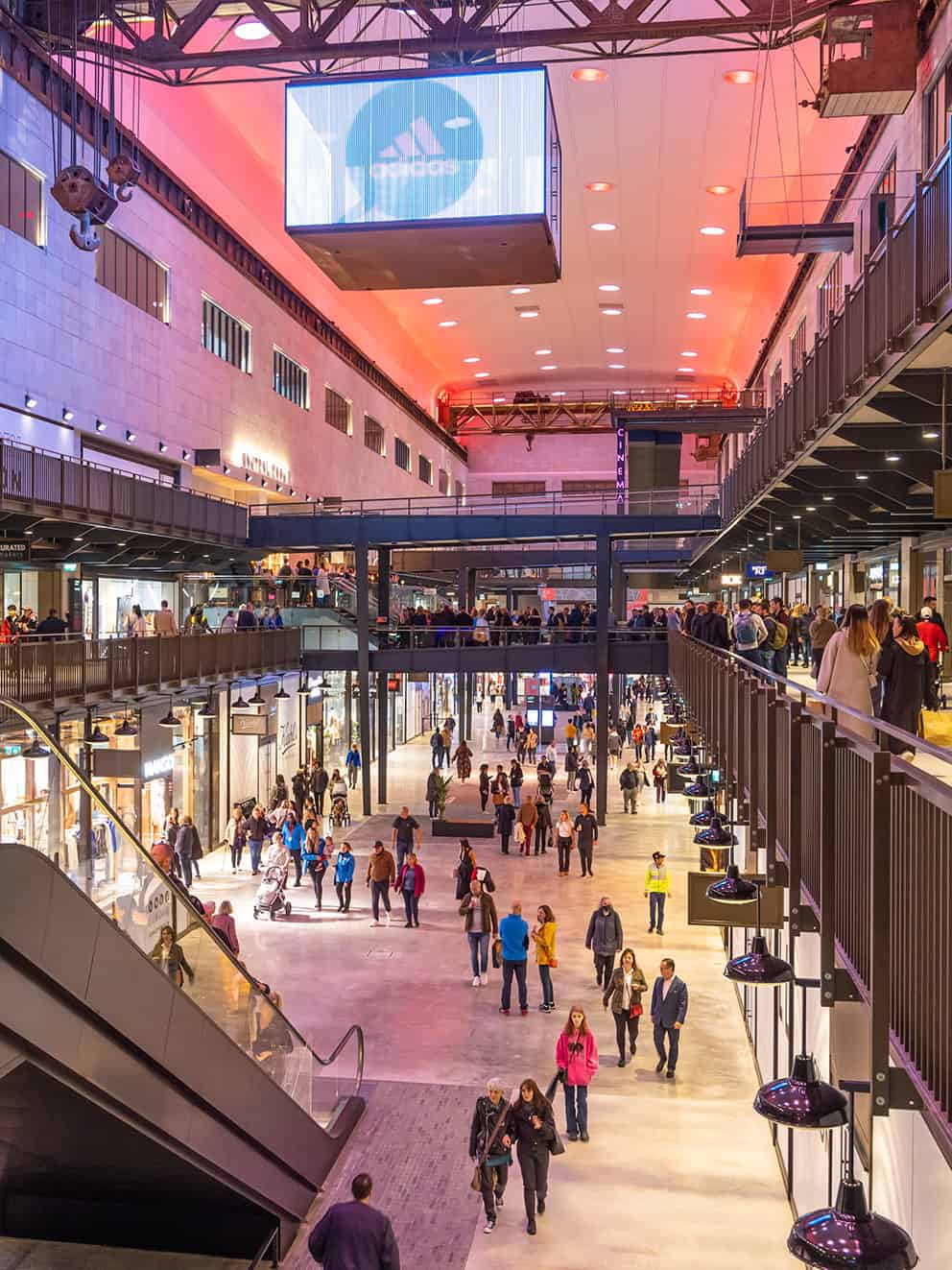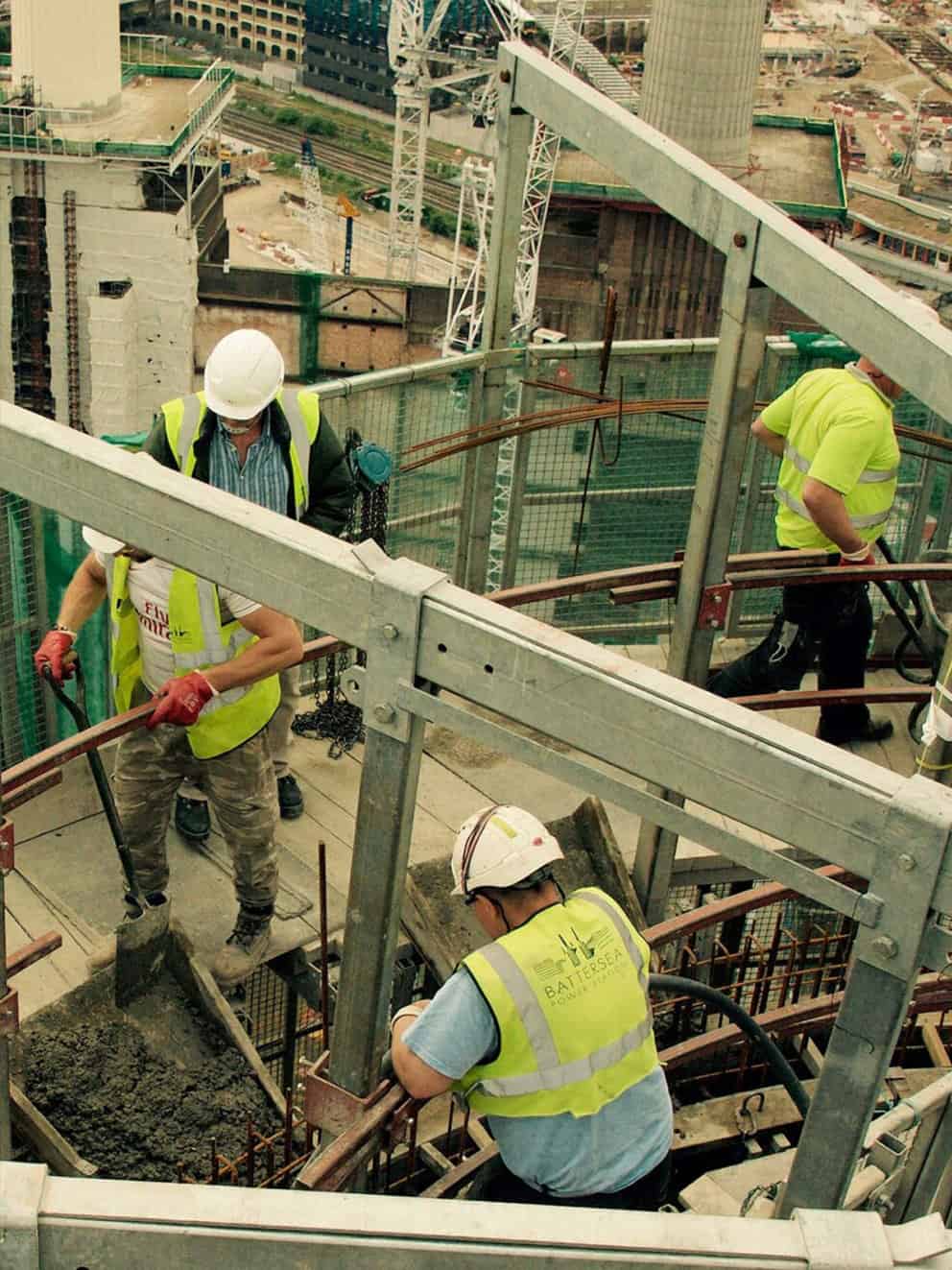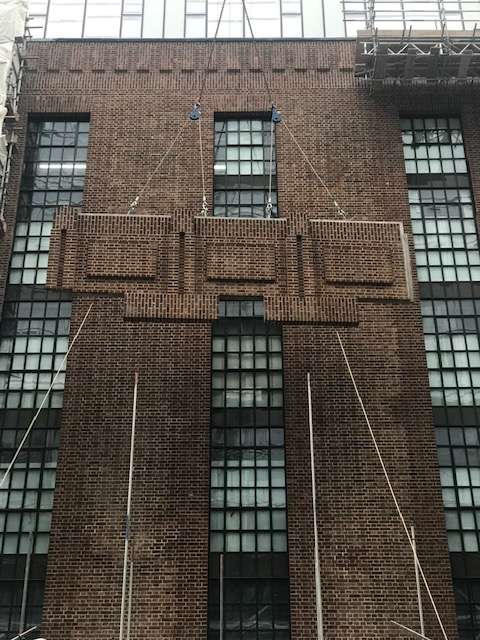At the heart of the 42-acre development lies the Grade II* listed Power Station. The architectural practice, WilkinsonEyre, were appointed in 2013 for the transformation and refurbishment, with the designs consistent with Sir Giles Gilbert Scott’s original vision.
Key to the proposals were that visitors should always be aware of the huge scale of the building, and that they should always know, wherever they are, that they are in Battersea Power Station.
To learn more about the Heritage and Discovery Trail around Battersea Power Station, click here.
TURBINE HALL A
Turbine Hall A has been restored to its Art Deco splendour with the roof and end windows reglazed, having been covered up during World War II, and allowing daylight to stream into the space. The old gantry cranes and travelling rail have been left as raw reminders of the past, as are the knocks visible on the faience at the southern end of the Turbine Hall.
Footprints of the old turbine machinery have been laid in brick on the floor and the ghost of the original Greek key pattern, still visible on the balconies either side of Control Room A, can be seen obliquely on the new balustrades surrounding the hall.


TURBINE HALL B
In contrast, the austere Turbine Hall B reflects 1950s modernism, the faience, although the same colour, is smooth with no adornment. Control Room B, overlooking the cavernous space, has been opened as a cocktail bar, set in amongst the original dials and controls including two wonderful octagonal synchroscopes which echo the octagonal columns.
Again, the footprints of the original turbines are laid in brick on the floor of the Turbine Hall and one of the old gantry cranes has been restored to move the modern ‘bandstand’ both vertically and horizontally through the hall.
NORTH AND SOUTH ATRIUMS
The old brick walls in both the north and south atriums have been left exposed all the way up to the roof with the new structure pulled back within the building. In the north the remnants of the old staircases and even bits of tiling from old washrooms are left exposed telling the story of the Power Station’s industrial past. Likewise, the steel beams, instead of being hidden have also been left exposed, with the new sleek steel next to the heavily riveted originals.
The south atrium wall is supported by a modern feat of engineering, a bow string truss, and the glass ceiling allows glimpses of the southern chimneys.


REBUILDING THE CHIMNEYS
Just over a decade ago, a steering group was formed to carry out a thorough and transparent investigation into the condition of the chimneys and to consider the best future strategy for them. The group, which included concrete repair specialists, conservation engineers and corrosion consultants, undertook rigorous laboratory testing of numerous samples from all four chimneys which were under a Dangerous Structures Notice.
The testing showed the concrete to have high chloride content and to be carbonated, resulting in corrosion of the steel reinforcement. The extensive conversations that followed, between industry experts, the developers, the local planning authority and Historic England, confirmed the course of action required.
Overseen by Historic England, work began in 2014 to painstakingly dismantle and carefully rebuild all chimneys to the precise specification of the originals. By doing this, the chimneys will have the same lifespan as that of the rest of the restored Power Station.
The team responsible for this programme used the original architects’ plans and specifications and therefore ensured the reconstructed chimneys were identical to their predecessors. One of the original methods used required over 25,000 wheelbarrows of concrete to be poured by hand into shuttered layers in each chimney.
BRICK REPLACEMENT
Its years as an active power station and weathering had left some of the six million bricks that make up Battersea Power Station, badly damaged in places.
Two brickmakers that made the original bricks to build Battersea Power Station in the last century were tracked down and tasked with hand throwing 1.75 million more to match the originals.
The original bricks, known as Golden Brown Pressed, came from Northwick Brick and Tiles, a firm founded by the World War I hero and art collector Captain E G Spencer-Churchill, a cousin of Winston Churchill.
The family-owned business (now known as Northcot Brick) is still based at the same Gloucestershire quarry as it was all those years ago with access to the same Lower Jurassic and Middle Lias clay that was used for the original bricks. Northcot Brick provided 1.3 million bricks, all of which have been blended and hand moulded, to be used to restore parts of the Power Station built in the 1930s and 1940s.
Blockleys, in Shropshire, provided circa 440,000 wire-cut bricks to be used on the parts of Power Station B dating from the 1950s.

